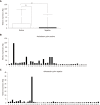Characterization and strong risk association of TLR2 del -196 to -174 polymorphism and Helicobacter pylori and their influence on mRNA expression in gastric cancer
- PMID: 32461785
- PMCID: PMC7235183
- DOI: 10.4251/wjgo.v12.i5.535
Characterization and strong risk association of TLR2 del -196 to -174 polymorphism and Helicobacter pylori and their influence on mRNA expression in gastric cancer
Abstract
Background: Toll-like receptor-2 (TLR2) is responsible for recognizing Helicobacter pylori (H. pylori) and activating the immune response. Polymorphisms in TLR2 may modulate gastric carcinogenesis.
Aim: To evaluate whether the TLR2 19216T/C (rs3804099) and TLR2 -196 to -174 ins/del (rs111200466) polymorphisms contribute to gastric carcinogenesis in the Brazilian population, and to determine the influence of both polymorphisms and H. pylori infection on TLR2 mRNA expression.
Methods: DNA was extracted from 854 peripheral blood leukocyte or gastric tissue samples [202 gastric cancer (GC), 269 chronic gastritis (CG), and 383 control/healthy (C)] and genotyped by allele-specific PCR or restriction fragment length polymorphism (RFLP)-PCR. Quantitative polymerase chain reaction by TaqMan® assay was used to quantify TLR2 mRNA levels in fresh gastric tissues (48 GC, 36 CG, and 14 C).
Results: Regarding the TLR2 -196 to -174 polymorphism, the ins/del and del/del genotypes were associated with a higher risk of GC by comparison with the C in all of the analyzed inheritance models (codominant, dominant, recessive, overdominant and log-additive; P < 0.0001). Similarly, an increased risk was observed when comparing the GC and CG groups [codominant (P < 0.0001), dominant (P < 0.0001), recessive (P = 0.0260), overdominant (P < 0.0001) and log-additive (P < 0.0001)]. In contrast, TLR2 19216T/C was associated with a protective effect in the GC group compared to the C group [dominant (P = 0.0420) and log-additive (P = 0.0300)]. Regarding the association of polymorphisms with H. pylori infection, individuals infected with H. pylori and harboring the TLR2 -196 to -174 ins/del polymorphism had an increased risk of gastric carcinogenesis [codominant (P = 0.0120), dominant (P = 0.0051), overdominant (P = 0.0240) and log-additive (P = 0.0030)], while TLR2 19216T/C was associated with a protective effect [codominant (P = 0.0039), dominant (P < 0.0001), overdominant (P = 0.0097) and log-additive (P = 0.0021)]. TLR2 mRNA levels were significantly increased in the GC group (median RQ = 6.95) compared to the CG group (RQ = 0.84, P < 0.0001) and to the normal mucosa group (RQ = 1.0). In addition, both H. pylori infection (P < 0.0001) and the presence of the polymorphic TLR2 -196 to -174del (P = 0.0010) and TLR2 19216 C (P = 0.0004) alleles influenced TLR2 mRNA expression.
Conclusion: The TLR2 -196 to -174 ins/del and TLR2 19216 T/C polymorphisms are strongly associated with GC. TLR2 mRNA expression levels are upregulated in neoplastic tissues and influenced by both the presence of H. pylori and variant genotypes.
Keywords: Chronic gastritis; Gastric cancer; Gene expression; Helicobacter pylori; Polymorphisms; Toll-like receptor 2.
©The Author(s) 2020. Published by Baishideng Publishing Group Inc. All rights reserved.
Conflict of interest statement
Conflict-of-interest statement: The authors have no conflicts of interest to declare.
Figures



Similar articles
-
Toll-like receptor 9 polymorphisms and Helicobacter pylori influence gene expression and risk of gastric carcinogenesis in the Brazilian population.World J Gastrointest Oncol. 2019 Nov 15;11(11):998-1010. doi: 10.4251/wjgo.v11.i11.998. World J Gastrointest Oncol. 2019. PMID: 31798780 Free PMC article.
-
Polymorphisms of the TLR2 and TLR4 genes are associated with risk of gastric cancer in a Brazilian population.World J Gastroenterol. 2012 Mar 21;18(11):1235-42. doi: 10.3748/wjg.v18.i11.1235. World J Gastroenterol. 2012. PMID: 22468087 Free PMC article.
-
TLR2 and TLR4 polymorphisms influence mRNA and protein expression in colorectal cancer.World J Gastroenterol. 2015 Jul 7;21(25):7730-41. doi: 10.3748/wjg.v21.i25.7730. World J Gastroenterol. 2015. PMID: 26167073 Free PMC article.
-
Genetic variants of toll-like receptor 2 and 5, helicobacter pylori infection, and risk of gastric cancer and its precursors in a chinese population.Cancer Epidemiol Biomarkers Prev. 2011 Dec;20(12):2594-602. doi: 10.1158/1055-9965.EPI-11-0702. Epub 2011 Oct 12. Cancer Epidemiol Biomarkers Prev. 2011. PMID: 21994405
-
Pattern-recognition receptors and gastric cancer.Front Immunol. 2014 Jul 22;5:336. doi: 10.3389/fimmu.2014.00336. eCollection 2014. Front Immunol. 2014. PMID: 25101079 Free PMC article. Review.
Cited by
-
The Role of Toll-Like Receptor-2 in Clostridioides difficile Infection: Evidence From a Mouse Model and Clinical Patients.Front Immunol. 2021 Jul 12;12:691039. doi: 10.3389/fimmu.2021.691039. eCollection 2021. Front Immunol. 2021. PMID: 34322122 Free PMC article.
-
Context-dependent functions of pattern recognition receptors in cancer.Nat Rev Cancer. 2022 Jul;22(7):397-413. doi: 10.1038/s41568-022-00462-5. Epub 2022 Mar 30. Nat Rev Cancer. 2022. PMID: 35355007 Review.
-
Common variants in toll-like receptor family genes and risk of gastric cancer: a systematic review and meta-analysis.Front Genet. 2023 Nov 28;14:1280051. doi: 10.3389/fgene.2023.1280051. eCollection 2023. Front Genet. 2023. PMID: 38090147 Free PMC article.
-
Single Nucleotide Polymorphisms Associated With Gut Homeostasis Influence Risk and Age-at-Onset of Parkinson's Disease.Front Aging Neurosci. 2020 Nov 17;12:603849. doi: 10.3389/fnagi.2020.603849. eCollection 2020. Front Aging Neurosci. 2020. PMID: 33328979 Free PMC article.
-
Toll-like receptors in health and disease.MedComm (2020). 2024 Apr 29;5(5):e549. doi: 10.1002/mco2.549. eCollection 2024 May. MedComm (2020). 2024. PMID: 38685971 Free PMC article. Review.
References
-
- Correa P. A human model of gastric carcinogenesis. Cancer Res. 1988;48:3554–3560. - PubMed
LinkOut - more resources
Full Text Sources
Miscellaneous

